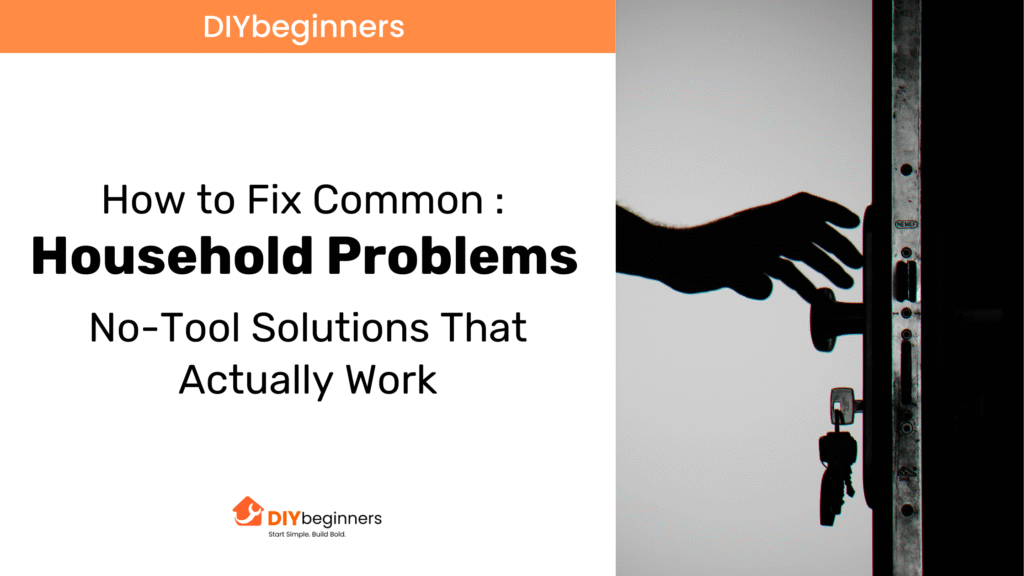
Did you know that if you undertake your own repairs (household problems) and handle household mishaps yourself, you can save yourself hundreds or thousands of dollars?
As an example, when your sink is going down slowly or your washing machine is not cleaning well enough, a plumber will tend to charge you at least a hundred dollars before that doctor ever gets under the door. Rather than picking up the phone, we have learned here that most household repairs can be completed without specialized equipment or extensive knowledge.
Consider plumbing problems, for example. A clogged-up bathroom sink can be cleared easily and quickly using simple products you likely already have in the kitchen: baking soda and white vinegar. Or maybe your washing machine just cannot properly clean clothes because it does not use water warmer than 65 degrees, which does not allow the detergent to dissolve.
This is why we have developed this guide on how to tackle everyday household issues without calling in the expensive help.
From squeaking doors to short-circuiting outlets, we will demonstrate ways to use simple household objects to make your fixes to problems around the house. Let us get to difficulties righted!
Quick Fixes for Everyday Annoyances
Many small household issues can drive us crazy daily. Fortunately, some of the most irritating problems around the house can be fixed without any special tools.
1. Silence squeaky door hinges with petroleum jelly..
To make some squeaky doors less irritating, simply apply Vaseline to the noise-causing parts to adjust. Petroleum jelly can also serve as a door hinge lubricant because it is oily. Unlike liquid lubricants, in which the lubricants may spill off and cause a mess, petroleum jelly does not.
To muzzle the cripple
- Rub on the hinge on the outside with a bit of petroleum jelly
- Rub it in space in the hinge joints thoroughly
- To provide an even more competent remedy, take out the hinge pin, then cover it with petroleum jelly and insert it back again..
The petroleum jelly sinks into the hinge and fixes there, preventing contact between metal and metal that causes a squeak. Moreover, it cannot go away and leave a mess as other lubricants could do.
2. Stop floorboards from creaking using baby powder..
Another everyday object that you can eliminate the squeaks of is your creaking floorboards that signal your midnight kitchen visits. Baby powder will serve as a lubricant between pieces of wood that are pushing against each other and causing noise.
Just pour in baby powder on the squeaky part and rub it into the fitting in between the floorboards. Traveling between the boards is easier due to the reduction in friction provided by the powder. Wipe off any powder that is on the surface after application. Baking soda and powdered graphite can also do the job when you do not have baby powder at hand.
3. Fix a rattling door with a strike plate bend..
Misadjusted interior doors that do not fit into the doorstop snugly are likely to develop irritating rattles and bangs. This normally occurs as a result of the misalignment between a door stop and a door.
The quickest and easiest to do with no tools at all. Bend in minuscule tang the little lip on the strike plate towards the door. As the door closes, it slackens the door off the stop a little and takes up the latch with greater tightness, usually quite sufficient to eliminate the rattle.
You might feel like using pliers, but they can ruin the finish on the plate. Rather, use two adjustable wrenches that are more suited to this task, should you require tools.
Simple Solutions for Plumbing Problems
Most of the frustrating household problems are connected to the plumbing system, and it is possible to solve a range of them without the help of a repairman. Most of these issues can be solved with the help of a very limited number of household ingredients, and save you a fortune at the same time.
1. Unclog a sink with baking soda and vinegar.
When dealing with a clogged sink with poor drainage, even slow draining can be handled well by this natural remedy:
- Put half a cup of baking soda straight in the drain
- a half a cupful of white vinegar
- Right away, the k drain with a cloth or a plug to intensify foaming motions
- Wait 30-60 minutes to make the mixture work
- Lastly, put boiling water down the drains to wash the loosened debris away
They can clear a clog using a reaction of vinegar (an acid) and baking soda (an alkali). By combining the two elements, the mixture produces carbon dioxide bubbles, which help to loosen blockages. The heated boiling water then gives pressure that assists in pushing through the pipes.
2. Remove showerhead buildup with a vinegar soak.
Showerheads, when clogged with mineral deposits, produce uneven sprays with a decrease in water pressure. To clean and still have the showerhead in place.
Heat half a bag of white vinegar inside a plastic bag, tie it up over your showerhead so that the nozzles are completely under the vinegar. Soak it overnight unless it is a brass, gold, or nickel-plated showerhead, in which case soak no more than 30 minutes,,s as the finish might be damaged. Subsequently, do the same by letting hot water gush into the showerhead to wash away any loosened deposits.
3. Seal cracked caulking around tubs and sinks..
Broken caulk makes a room look sloppy and may even cause water to infiltrate behind fixtures and damage them. To resolve this, it is helpful to take examples.
One, strip away the old caulk with a utility knife. Rub the area clean with rubbing alcohol and allow it to dry. Apply new caulk, especially the beading that is ibathroom-specifici, along the seam. To seal securely against water, moisten the finger and rub the caulk against the rim and against the counter. Allow it to dry as per the product’s guidelines before subjecting it to water; this is normally about 12 hours.
Appliance and Electrical Fixes Without Tools
1. Reset a tripped GFCI outlet..
Ground Fault Circuit Interrupter (GFCI) receptacles have peculiar test and reset buttons, and they are common in kitchens and bathrooms, among other places that are likely to get wet. These safety outlets automatically switch off power in case they sense possible electrical hazards. After a tripped GFCI, how to reset a tripped GFCI
- Unplug everything plugged into the outlet and other outlets close to the outlet on the same circuit.
- Hold the reset button (usually red) until you can hear a click
- The outlet should be tested by inserting an allow-complexityevice
When the outlet keeps tripping, unplug all the devices, reset it, and plug them back in, one at a time, to figure out which is causing the issue.
2. Fix a garbage disposal with the reset button..
In most cases, when your garbage disposal is not working, ee if the reset button of your garbage disposal is red at the bottom. To successfully restart
- Make sure to be sure to turn off the disposal switch
- The red square button will be under the disposal
- Push it in our devastatingLY hard until it clicks into place
- Leave it for ten minutes before attempting to get it to work again
3. Check the oven timer settings if it won’t heat
Other times, an oven that fails to heat correctly may have been improperly set in terms of timer settings. Newer ovens can be driven to confusion by including notification systems as well. Working essentially, the preheat light or timer indicator is not always an accurate display of what the actual temperature of the oven is. During troubleshooting:
- Ensure that the settings of the timers are not in delay mode
- Provide sufficient preheating time (at least 30 minutes to do meaningful temperature readings)
- Remember that the temperature inside the oven increases more rapidly than the metal encapsulated in the ovenís interior.
Furniture and Fixture Repairs Made Easy
1. Tighten loose knobs with nail polish or glue.
Wobbly cabinet knobs and loose drawer knobs are the bane of the day, though they are tightened now and then. Clear nail polish serves as a good remedy, making a union between the screw threads and the good surrounding apply.
- Turn the knob all the way out
- Lay on using clear nail polish on the screw threads
- Put the knob back and fasten it.
- Leave to dry for about an hour.
2. Fix a sagging drawer with plywood reinforcement..
The drawers tend to curl up when there is a weight pressing them out of their grooves. In a permanent mend
Turn the drawer bottom first and push the top of the drawers back into the groove. Cut a board of 1/4 inch plywood to exactly fit in between the sides of the drawers. These reinforcement strips are placed behind the original bottom of the drawers and are glued. To strengthen it further, screw it into the bottom of the drawers into the new support.
3. Use candle wax to fix sticking drawers.
Wooden drawers can bind when they have been humidified or used regularly. The waves of the candle wax make a smooth surface that glides.
Take the whole drawer out. Light a warning paraffin or beeswax candle and burn it down, both the runners of the drawers and the part of the tracks on which they slide inside the cabinet. Put the drawer back in and make it slide easily a few times to spread the wax.
Conclusion
When household repairs are involved, it is obviously cheaper and saves time to carry them out yourself. We have learned, throughout this guide, about extensively used everyday items that can handle some problems that would otherwise be quite costly to address through professional assistance.
You can now be confident in fixing those long squeaking hinges or delayed drains yourself without calling an expert. And best of all, these solutions do not need any special or technical tools or skill sets; they simply require what you already have at home.
The psychological reward of solving something yourself is yet another advantage because it is a big plus that exceeds the financial gains. That squeaking door or jamming drawer that had been irritating you for months, now you know how to quiet it down in a few minutes.
Remember that what first appears to be an emergency may just have a simple solution. There are simple solutions to blown outlets and blocked sin. Instead of dialing a plumber or electrician, before doing so, it is best to examine the following tips. Considering that, in any case, you will still require professional assistance, you will obtain the best result by spending just a couple of minutes and saving a few pennies.
We would like our solutions to make your home maintenance less hectic. A broken or malfunctioning item around your home could be solved next time by looking through your pantry or medicine cabinetbecause the solution could be right in front of you.
